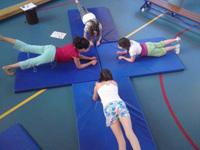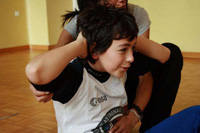This is an archive of information released in the past.
Disclaimer: It may contain broken links or outdated information. Some parts may not function in current web browsers.
*Visit https://humans-in-space.jaxa.jp/en/ for the latest information.

Benefits for Humanity
- Benefits for Humanity
- Program Science Forum
- International Partners
Students Get Fit the Astronaut Way
Jessica Nimon, International Space Station Program Science Office
NASA Johnson Space Center
When you think of NASA, you likely picture the space shuttle or International Space Station or have images of planets and galaxies flashing before your mind’s eye. NASA’s Mission X: Train Like an Astronaut, however, focuses a little closer to home. Working with the schools in our very own neighborhoods and around the world, Mission X uses the same skills used to train astronauts to motivate physical education for around 3,700 students in 40 cities around the globe.

Students at Daltonbasisschool de Tjalk in Lelystad, Netherlands, participate in the building an astronaut core activity. (Courtesy of ESA)
The brainchild of the International Space Life Science Working Group, or ISLSWG, and the Human Research Program Education and Outreach, or HRPEO, Mission X launched in U.S. schools Jan. 18, 2010. NASA’s Human Research Program funded the pilot program, including activity and educational modules and an interactive Web site (http://www.trainlikeanastronaut.org). The program is available in six different languages for participants in 10 countries -the U.S., the Netherlands, Italy, France, Germany, Japan, Australia, Columbia, Spain, and the United Kingdom. The goal of the program is to make kinesiology and nutrition fun for children by encouraging them to train like an astronaut.
Chuck Lloyd, the NASA program manager responsible for the project, comments on how the space program excites students, prompting active participation. “Mission X is all about inspiring and educating our youth about living a healthy lifestyle with a focus on improving their overall daily physical activity with the Mission X physical activities, known as train-like-an-astronaut.”
Students ranging from 8 to 12 years old learn about the science behind their activities, including the importance of hydration, bone health, and balanced nutrition. Known as “fit explorers,” these youth stay motivated with fun ways to gauge their success. For instance, they can see what other schools are doing on the Train Like An Astronaut blog. Fit explorers logged their accumulated activity points over the course of the program to help an online cartoon astronaut, known as Flat Charlie, Walk to the Moon. Flat Charlie made it to the Moon five weeks into the competition -a distance of 238,857 miles (384,403 km) or 478 million steps- and he’s still going!

Students at Media Sandro Pertini school in Savona, Italy, participate in the Building an Astronaut Core activity. (Courtesy of ASI)
Fit explorers learn that astronauts train before, during and after missions to maintain top physical health via good nutrition, rest and physical activity habits to function in the demanding environment of microgravity. Lloyd makes the connection of such health-centric mindsets for everyone, even those not planning to launch into space. “Our youth must also make smart choices on balancing the amount of work, play and sleep they get to remain in peak performance. Education is critical to our youth and to our communities to ensure we have tomorrow’s workforce and technical leadership to address the rigors of our societies.”
The first phase of the challenge, which lasted for six weeks, had schools participating with each other within their own countries in a friendly competition. The second phase of the challenge will be an ongoing multi-year Mission X Train Like An Astronaut challenge that will be expanded to more students and more countries.
| Copyright 2007 Japan Aerospace Exploration Agency | Site Policy |







